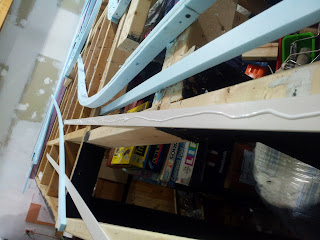Now that design for the construction method is pretty much out of the way, it's time to start building again. As always, the roadbed is being built from the top of the grade down. What's more the road bed itself will be completed before the supports are places permanently. This supports will then be installed and adjusted to create a smooth ascent up the hill. I know it's unconventional but it allows me to set the highest elevation and then work out the length of the slope to get the exact percent grade I'm looking for. What's more I can lower the percentage of the grade if I find I have the room to lengthen it...
 |
| Grade "Choices" |
 |
| Revised Track Plan: Curve Names |
At 2% the grade extends for BO (SLOPE) to UN which is pretty much what the "old" roadbed was set too. If, however I start the grade at JK (ALTO) the distance allows a 1% grade, but the trains hit The Hill too early for my tastes. They have a ways to go before reaching their helpers at BO. Trains that do stop at BO are completely on the grade, not an ideal situation for a heavy train. If I fudge and move the base of the grade to the middle of Brickyard, the only part of the train is on the grade when the helpers are attached at BO. Having only part of the train on The Hill makes starting a lot easier. The point is that beginning the roadbed from the top of the grade gives me these choices.
The roadbed under Llyswen Yards is already in place. Two sheets of 16" x 96" pink extruded foam are located there but have yet to be fastened down. I'm working out where to place the rest of the 4' x 8' slab they were cut from. The freight mains here will run on the roadbed with the yards, although they are elevated about 1/4" by the ballast strip. The passenger mains run to the"north" of the yards, bypassing them on their own two track spline roadbed. All the track outside Llyswen is also run on spline roadbed. Between Llyswen and BF tower the mainline is four track and sits on a lamination of 8 splines. The balance of the mainline, except the helix, is double tracked and supported by a lamination of 4 splines. The helper loop at Tunnel Hill and several other single tracks run on 2 spline laminations. The helix is four tracks supported on plywood.
Alrighty then...Some photos of the construction underway...
 |
| Llyswen Yards |
 |
| Foam "Shims" Under East Keystone |
 |
| Plywood Shims Under GD |
I had to place shims under the pink foam. For the most part it rests atop the "library". The bookshelf is 15 feet long and follows the slope of the garage floor. I had to put 1/2" shims on the East Keystone end, but was able to get by with 1/4" shims at GD.
Construction starts at Tunnel Hill. Single, double and four track roadbed are all used in this small area...
The main line is four track up until BF tower at Remington. There it splits into two tracks eastbound and two single tracks westbound. The eastbound mains stays double tracked until they approach the helix where they merge with the westbound tracks. The westbound mains run as two single tracks until UN tower. There they merge back to two tracks. They rejoin the eastbound mains as all approach the helix. There is also a short section of single track roadbed for the helper loop.
On the single track roadbed the "soft" splines are laminated to either side of the hard spline, which runs down the middle of the roadbed. The splines are arranged so that they present a flat surface on top. The tallest of the three, the hard spline, protrudes beyond the adjacent soft splines, creating a shallow "T" shape. The vertical supports that hold the roadbed will be notched to match this protrusion and keep the roadbed centered. The hard splines protrude on the other types of roadbed for the same reason...
 |
| Bottom of Single Track Roadbed |
The lamination is done the same on all roadbed sections. First a bead of glue is run down the center of the spline...
 |
| "First a bead of glue is run down the center of the spline" |
I spread the glue by rubbing the two splines together until the glue covers both in a pretty even coat. I've taken to calling this process "smegging". Just seemed the proper term for smearing a mess...
 |
| "Smegging" |
When I assemble the splines into roadbed I try to stagger the joints by half their length. On the single track, this means that the soft spline joints are centered on the hard splines. On double track I stagger the outer two soft splines the same way. The center splines are staggered from the outer, but not from each other...
 |
| Two Track Staggered Joints |
On the four track I do pretty much the same thing. It's essentially two of the two track roadbeds set side by side.
Time to call it a day...
Regards,
Frank Musick
Chief Cook and Bottle Washer
 |
| Allegheny Eastern Railroad |



No comments:
Post a Comment